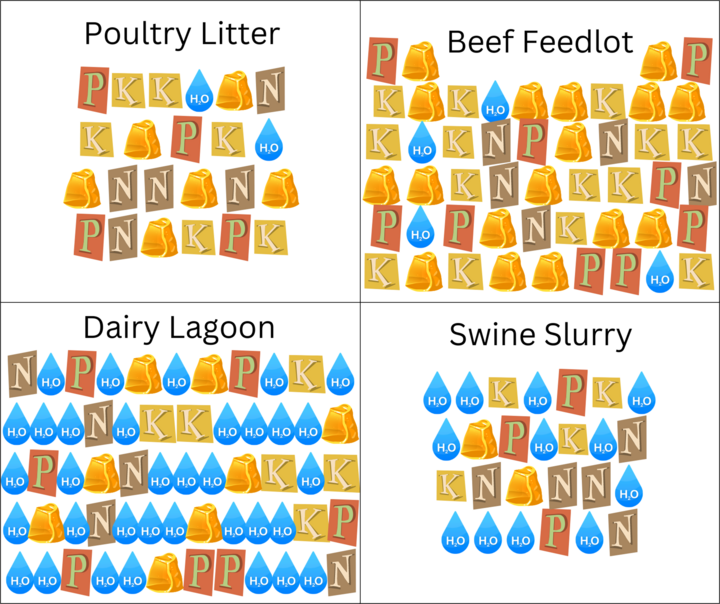Not All Manure is Created Equal

A visual representation of various manures' nitrogen (N), phosphorus (P), and potassium (K) contents compared to volume of organic matter and water.
Chicken, beef cattle, swine, and dairy cows all produce manure. All of these manure types are valuable, but are they equal? Absolutely not. I could rank them by smell, another person might rank by nutrient content, another person by their proximity to them, and yet someone else could separate them for their ability to influence soil health characteristics. This article will discuss a little about the different kinds of manure and explain why not all of this valuable product is created equal.
Nutrient Differences
Based on some analyses that I have accumulated from various sources in Nebraska, all of the following manure application rates provide approximately 150 pounds of nitrogen (N) available for next year’s crop if applied this fall:
- 5000 gallons per acre of swine manure (injected),
- 18 tons per acre of beef manure (surface applied),
- 15,000 gallons of dairy slurry (injected), and
- 6 tons per acre of poultry litter (surface applied).
That means it would take three times as much beef manure to provide the same amount of nitrogen as poultry litter. Three times! But the beef manure would provide significantly more organic matter than the poultry litter. So, depending on your goals, either could be a good option for your cropping system.
What about the other nutrients in manure? The following table shows estimates of available nutrients when each manure is applied at the rate indicated above.
| Nitrogen (N) available at N rate | Phosphorus (P) available at N rate | Potassium (K) available at N rate | |
|---|---|---|---|
| Swine pit slurry | 154 | 118 | 95 |
| Beef feedlot | 154 | 282 | 420 |
| Dairy lagoon | 154 | 203 | 186 |
| Poultry litter | 154 | 121 | 169 |
Here we see that beef manure at the same N rate would supply more than twice as much phosphorus as swine slurry or poultry litter and more than four times the amount of potash as swine manure. So, if you’re applying to a field that has sufficient soil phosphorus concentrations, you might gain more value from a product like swine manure if it’s available near that field. However, if the field you want to apply to is needing phosphorus, beef manure might be just the ticket to help build up that soil phosphorus concentration, improve soil properties through organic matter inputs, and offset your commercial fertilizer costs for a number of years.
Logistics of Differing Manures
While balancing nutrients is important, you also have to consider the availability and characteristics of the product. Swine and dairy manures are more expensive to transport compared to drier solid manures due to their high water content. They’re just too heavy and therefore costly to haul greater distances. This means they may not be economical options everywhere in the state.
Manure's Ability to Build Soil Health
There's not a lot of research on how different types of manure impact soil health, but we know one thing for sure: Manure is superior to commercial fertilizer for building soil organic matter concentration and increasing the water-holding capacity of soils. We also know that solid manures, like beef manure and poultry litter, typically contain larger concentrations of organic matter than more dilute slurry and liquid forms of manure, which benefits soil. If left on the soil surface, manures with organic matter can even have a mulch-like effect, conserving soil moisture and decreasing erosion and runoff.
When you're trying to balance nutrients needed on your fields, it's good to know what's in your manure and to remember that not all manure is created equal. If you're considering using a manure product, be sure to think not only about availability of different manure types, but also about the nutrient contents and the characteristics of the products.

This article was reviewed by Mara Zelt, Amy Schmidt, and Todd Whitney.